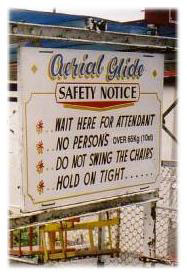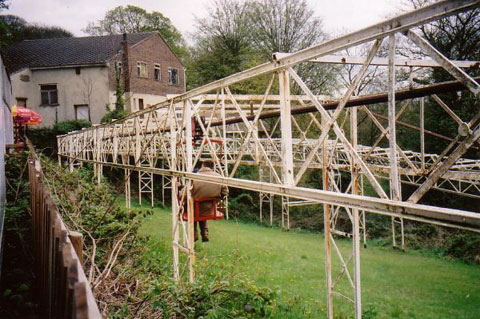|
|
|
| HOME ARTICLES GALLERIES ABOUT US FORUM LINKS CONTACT JOYLAND BOOKS | |
|
A TALE OF SHIPLEY GLEN: THE MIKE SHORT INTERVIEW (PART 2) Interview by Gary Radice Article: Added November 2003 |
|
|
How
and when did the campaign start?
An
application for outline planning permission to develop the site
for housing was submitted in August 2002.
My wife (Di Millen) and I, together with our neighbours,
Paul and Cathy Roberts realised we would have to move fast.
We started by contacting the local newspaper.
Shipley Glen and the Pleasure Grounds occupy a
place in the heart of tens of thousands of Bradfordians and the story made a big splash.
We followed it up with a petition over the August
Bank Holiday. We erected a stall just inside our driveway.
Most of the time we couldn't be there and simply
left petition forms and a leaflet explaining what was happening.
Around 2200 people signed the petition and that
was presented to the local Planning Panel along with a formal objection in early September.
The local paper, the Telegraph and Argus again
covered the story:
See www.joylandbooks.com/shipleyglen/
for the text of the articles.
Everything went quiet and for some reason the
Shipley Planning Panel did not consider the planning application and it was not until 15 May 2003 that the item appeared on
their agenda.
We then realised why the item might have been
delayed.
The local council elections
had just been held and this was a hugely sensitive issue with massive public opposition to the destruction of the Pleasure
Grounds.
It was likely that 'the powers that be'
didn't want the item around during the election and this could only mean that planning permission might well be granted after
the election.
We found out that, indeed, local authority officers
were advising that there were no legal reasons not to give permission.
Campaigner Paul Roberts went into overdrive and
came up with an argument that the legal requirements of the Government's Planning Policy Guidance 17 (PPG17) had not been
complied with and that the application must be rejected.
Paul's wife, Cathy, presented the arguments to
the Planning Panel as best she could within the five minutes allowed to her and she was superb. We also bombarded them
with documents containing the arguments and supporting information.
That threw the planning officers into a spin;
they clearly did not know what we were talking about and, after a site visit and an adjournment, the whole item was adjourned.
Strangely it did not appear on the next agenda
and we couldn't find out what was happening.
It was not until 15
October 2003 that we found out that the Planning officers had taken legal advice and that the advice supported our position,
but instead of rejecting the planning application, the Planning Panel had deferred it until after Christmas to allow the landowner,
Mr Teale, to consider his position.
A couple of days later, we got wind of the
possibility that the landowner might be planning to demolish the ‘Aerial Glide’.
During our campaign, I was surprised to
learn that virtually no one knew of the historical importance of the ride as the oldest surviving static amusement park ride
in the UK and the only surviving ride of its type.
This historical fact became an important
part of the case and presumably the landowner felt that if he pulled it down, the obstacle to planning consent would be removed.
We had to act fast and recalled that a ride
had been listed in Margate but we had no idea how to go about getting the 'Aerial Glide' listed.
We had seen Nick Laister’s article
on the ‘Aerial Glide’ on the Joyland Books website and on the 17 October we got in touch with him.
Nick responded the same day and agreed to
help us.
Using the work Nick had done on the listing
application for the Scenic Railway at Dreamland, Margate as a framework, I had a draft submission for listing ready in 48
hours.
Nick polished and improved it and gave me
lots of advice on legislation. It became a joint submission that I am very proud of. I couldn’t have done
it without Nick’s involvement.
Unfortunately, the rapidly developing London
postal dispute delayed submission but Nick used the time lost to prepare the ground for the application and he did lots
of lobbying.
The submission was eventually received by
The Department of Culture, Media and Sports. (DCMS) on 30 October and by 15.30hrs the following day we had secured Grade II
listed building status for the ride.
It must have been the fastest listing of
a building in history. The Local Authority officers responsible for heritage were contacted and we insisted that the
notice had to be served that night and at 18.15hrs an authority officer posted a letter through the landowners letterbox.
We thought the ride had been saved... |
|
|
|
|
|
THEMAGICEYE | Terms and Conditions | Privacy Policy | Contact Us |
|


